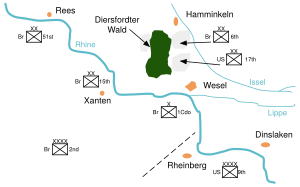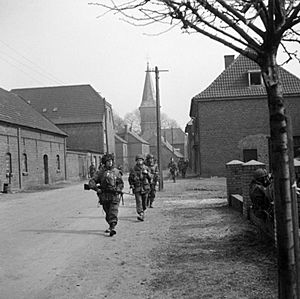Operation Varsity facts for kids
Quick facts for kids Operation Varsity |
|||||||
|---|---|---|---|---|---|---|---|
| Part of Operation Plunder | |||||||
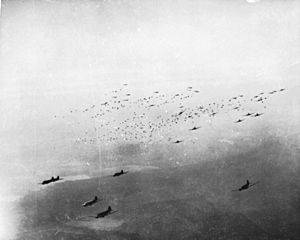 C-47 transport aircraft drop hundreds of paratroopers as part of Operation Varsity |
|||||||
|
|||||||
| Belligerents | |||||||
| Commanders and leaders | |||||||
| Units involved | |||||||
|
|
|||||||
| Strength | |||||||
| 16,870 | 8,000 (est.) | ||||||
| Casualties and losses | |||||||
| 2,378–2,700 casualties 72 aircraft |
Unknown total casualties 3,500 captured |
||||||
Operation Varsity was a huge airborne mission by the Allied forces near the end of World War II. It happened on March 24, 1945. More than 16,000 paratroopers and thousands of aircraft were involved. This made it the biggest airborne operation ever done in a single day and at one location.
The goal of Operation Varsity was to help ground troops cross the Rhine River into Northern Germany. Two airborne divisions were dropped on the eastern side of the Rhine, near the village of Hamminkeln and the town of Wesel. Their job was to capture important areas and confuse German defenses. This would make it easier for the ground troops to advance.
Even with some mistakes, like paratroopers landing in the wrong place, the operation was a big success. Both airborne divisions captured bridges and towns that the Germans could have used to slow down the Allies. The Allied airborne troops had over 2,000 casualties but captured about 3,500 German soldiers. Operation Varsity was the last major Allied airborne mission of World War II.
Contents
Why Operation Varsity Happened
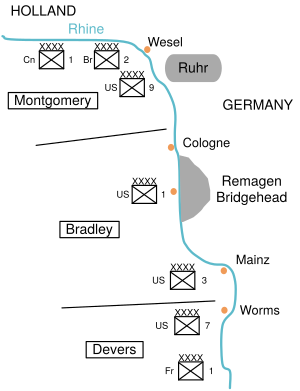
By March 1945, the Allied armies had moved deep into Nazi Germany. They reached the Rhine River, which was a very strong natural barrier. If the Allies could cross the Rhine, they would have a clear path to Berlin and other big cities in northern Germany.
General Dwight D. Eisenhower, the top Allied commander, decided to try crossing the Rhine in several places. Field Marshal Bernard Montgomery led the British and Canadian forces. He planned an operation called Operation Plunder to cross the Rhine. Eisenhower approved this plan.
To make sure Operation Plunder worked, Montgomery wanted an airborne attack to support the ground troops. This airborne part was named Operation Varsity. At first, three airborne divisions were chosen: the British 6th Airborne Division, the U.S. 13th Airborne Division, and the U.S. 17th Airborne Division.
The British 6th Airborne Division had a lot of experience. They had fought in Operation Overlord (the D-Day landings) in 1944. The U.S. 17th Airborne Division was newer. They had fought in the Battle of the Bulge but had not yet made a combat jump. The U.S. 13th Airborne Division was also new and had not seen much action.
Planning the Attack
Allied Preparations for Varsity
Operation Varsity was planned with the three airborne divisions in mind. They were supposed to drop behind German lines to help the ground forces cross the Rhine. However, it became clear that there weren't enough transport aircraft to carry all three divisions. So, the U.S. 13th Airborne Division was left out of the plan.
The mission was changed to use only the British 6th and U.S. 17th Airborne Divisions. Their main goal was to land near Wesel. They would disrupt German defenses to help the British Second Army advance towards Wesel.
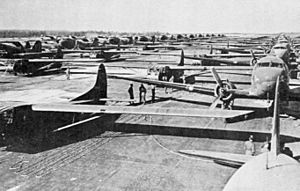
The divisions had specific jobs. They needed to capture the Diersfordter Wald (a forest overlooking the Rhine). This forest was important because Germans could use it for artillery. They also had to seize several bridges over the smaller River Issel. Finally, they had to capture the village of Hamminkeln. Once these goals were met, the airborne troops would hold their positions. They would wait for the Allied ground forces to arrive.
Operation Varsity was the largest single airborne lift of the war. Unlike earlier missions like Operation Market Garden, the airborne troops would drop after the ground troops had started crossing the river. This was done to reduce risks to the airborne soldiers. They would also drop closer to the front lines. This meant ground reinforcements could reach them quickly, avoiding the isolation that happened at Arnhem.
Allied airborne commander General Lewis H. Brereton decided both divisions would drop at the same time. This was another lesson from Market Garden. Supplies would also be dropped quickly to the airborne troops.
German Defenses
By this point in the war, Germany had fewer and weaker divisions on the Western Front. The Allies had over 30 divisions, while the Germans had only about 10. These German divisions were tired from constant fighting.
The main German force the Allies faced was the 1st Parachute Army. Even this army was weakened by earlier battles. They had three corps along the river. The 7th Parachute Division and 84th Infantry Division would face the airborne attack. Both divisions were under-strength, with only about 4,000 men each. The 84th Infantry Division had only about 50 medium artillery pieces.
German forces were low on soldiers and supplies. While farms and villages were set up for defense, there were few mobile reserves. This meant they couldn't easily move troops to counter the Allied attack. The Germans had about 150 armored vehicles.
The Germans also had many antiaircraft guns. Allied intelligence estimated they had over 100 heavy and over 700 light anti-aircraft guns. A week before Varsity, the Allies launched a huge air attack. More than 10,000 Allied planes attacked German airfields and transportation. This made it even harder for the Germans to defend.
The Germans didn't know exactly where the Allies would attack. They only realized the location when British engineers started setting up a long smokescreen near Emmerich.
The Battle Begins
Operation Plunder began at 9 pm on March 23. By early morning on March 24, Allied ground units had secured several crossings on the eastern side of the Rhine.
Hours later, the transport planes carrying the two airborne divisions for Operation Varsity took off. They flew from airbases in England and France. They met over Brussels before heading northeast to the drop zones. The airlift included 541 transport planes with troops. Another 1,050 troop-carriers towed 1,350 gliders.
The U.S. 17th Airborne Division had 9,387 soldiers. They were carried by 836 C-47 Skytrains, 72 C-46 Commandos, and over 900 Waco CG-4A gliders. The British 6th Airborne Division had 7,220 soldiers. They were carried by 42 Douglas C-54s and 752 C-47 Dakota planes, plus 420 Airspeed Horsa and General Aircraft Hamilcar gliders.
This huge fleet of aircraft stretched over 200 miles in the sky. It took 2 hours and 37 minutes for all of them to pass a single point. About 2,153 Allied fighter planes protected them. This combined drop of two divisions in one lift was the largest single-day airborne drop in history. At 10 am, British and American airborne troops began landing on German soil. This was about 13 hours after the ground assault started.
British 6th Airborne Division in Action
The first British unit to land was the 8th (Midlands) Parachute Battalion. They landed nine minutes early but successfully reached their drop zone. They faced heavy small-arms fire and anti-aircraft guns. The brigade had some casualties while fighting German forces in the Diersfordter Wald. But by 11:00 am, the drop zone was mostly clear.
The 9th (Eastern and Home Counties) Parachute Battalion and the 1st Canadian Parachute Battalion captured Schnappenberg. The Canadian unit lost its commander, Lieutenant Colonel Jeff Nicklin, shortly after he landed. Despite losses, the brigade cleared the area. By 1:45 pm, they had secured all their objectives. Canadian medical orderly Corporal Frederick George Topham earned the Victoria Cross for helping wounded soldiers, even though he was also hurt.
The 5th Parachute Brigade landed next. They faced poor visibility and heavy German fire. However, the 7th (Light Infantry) Parachute Battalion quickly cleared the drop zone. The 12th (Yorkshire) Parachute Battalion and 13th (Lancashire) Parachute Battalion secured the rest of the brigade's objectives. By 3:30 pm, they had secured all their goals and linked up with other British units.
The 6th Airlanding Brigade landed in gliders. They were tasked with capturing the town of Hamminkeln and several bridges. They landed under heavy anti-aircraft fire, haze, and smoke. Some gliders landed in the wrong places or crashed. However, most gliders made it. The brigade secured three bridges over the River Issel. They also captured Hamminkeln with help from American paratroopers who had landed nearby by mistake.
U.S. 17th Airborne Division in Action
The 507th Parachute Infantry Regiment was the first American unit to land. Due to heavy haze, many paratroopers landed away from their planned drop zone. Colonel Edson Raff gathered his scattered paratroopers. They fought a German artillery battery on their way to the correct drop zone. By 2 pm, the 507th PIR had secured all its objectives. They cleared the area around Diersfordt and destroyed a German tank. Private George J. Peters earned the Medal of Honor for bravely attacking a German machine gun nest.
The 513th Parachute Infantry Regiment was the second American unit. Their transport planes flew through heavy German anti-aircraft fire. They lost 22 C-46 planes and had 38 more damaged. Due to pilot error and haze, the regiment missed its own drop zone. They landed instead in a British landing zone. Despite this, the paratroopers quickly regrouped. They helped the British glider troops fight German artillery. A combined force of American and British troops then captured Hamminkeln. By 2 pm, the 513th had secured all its objectives. They destroyed two tanks and two artillery regiments. Private First Class Stuart S. Stryker also earned the Medal of Honor for leading a charge against a German machine-gun nest.
The 194th Glider Infantry Regiment landed accurately in its zone. However, their gliders and tow aircraft took heavy losses. Twelve C-47 planes were lost, and 140 were damaged by anti-aircraft fire. The regiment landed right in the middle of German artillery batteries. These batteries were firing at Allied ground forces crossing the Rhine. The glider troops quickly defeated these artillery positions. The 194th Glider Infantry Regiment secured its objectives. They destroyed 42 artillery pieces, 10 tanks, and other armored vehicles.
After the Battle
Operation Varsity was a big success. All the goals set for the airborne troops were achieved, often within hours. The bridges over the Issel River were captured. One bridge had to be destroyed later to stop German counter-attacks. The Diersfordter Forest was cleared of enemy troops. Roads that Germans might have used for reinforcements were cut. Hamminkeln, a key village, was also secured.
By the night of March 24, the British 15th Infantry Division had linked up with parts of the 6th Airborne Division. By midnight, the first light bridge was built across the Rhine. By March 27, twelve bridges for heavy vehicles were across the Rhine. The Allies had 14 divisions on the eastern bank, moving up to 10 miles inland.
A German commander, Generalmajor Heinz Fiebig, said his troops were very surprised by how fast the airborne divisions landed. He said their sudden appearance had a "shattering effect" on the outnumbered German defenders. His division had only about 4,000 soldiers left.
The U.S. 17th Airborne Division earned another Medal of Honor after the operation. Technical Sergeant Clinton M. Hedrick received it for helping capture Lembeck Castle, which the Germans had fortified.
Casualties and Losses
Both airborne divisions had many casualties, but fewer than expected. By the end of March 24, the 6th Airborne Division had about 1,400 soldiers killed, wounded, or missing in action. They also captured about 1,500 German prisoners. The 17th Airborne Division had about 1,300 casualties. They captured about 2,000 German prisoners. In total, about 3,500 German prisoners were taken by the airborne forces.
The air forces also suffered losses. Fifty-six aircraft were lost on March 24. Twenty-one of the 144 transport planes carrying the 17th Airborne were shot down. Another 59 were damaged by anti-aircraft fire. Sixteen bombers were also shot down during supply drops.
Why Varsity Was Praised
Many people, including General Dwight D. Eisenhower, called Operation Varsity a great success. Eisenhower said it was "the most successful airborne operation carried out to date."
Historians agree that the operation learned from past mistakes. For example, the airborne forces were dropped closer to the ground troops. This meant they didn't have to fight alone for long. Also, the drops happened after the ground forces had started crossing the Rhine. This was a big change from Operation Market Garden, where airborne troops were dropped far behind enemy lines.
Improvements were also made in supporting the airborne troops. Many artillery pieces were available to cover the landings. Observers were dropped with the troops to help direct fire. This gave the airborne forces more firepower.
Historian Peter Allen noted that while the airborne forces had heavy casualties, they drew German attention away from the Rhine crossing. This meant the ground troops crossing the river had fewer casualties. They were able to "break out from the Rhine in hours rather than days."
Criticism of Varsity
Despite the praise, some historians have criticized Operation Varsity. Some argue that the operation might not have been completely necessary. They suggest that if the same resources were used on the ground, the advance might have been even faster.
Aircraft Problems
One major problem was the lack of transport aircraft. This issue had affected all large Allied airborne operations. The original plan for Varsity included a third airborne division, the 13th. But because there weren't enough planes, this division was left out. This reduced the fighting power of the airborne force. However, the troops that were used were enough to defeat the German defenders.
There was also a shortage of gliders. New gliders had to be shipped from America and put together in Europe. Many gliders from earlier operations were not recovered.
High Losses of Troops and Planes
Losses of airborne troops were high. This was likely because the operation happened during the day. Planners believed a daytime drop would be more accurate and troops would be less scattered.
However, landing paratroopers and gliders in daylight made them very easy targets for anti-aircraft fire. Of 416 gliders that landed, only 88 were not damaged by enemy fire. Between 20-30 percent of glider pilots became casualties. Gliders were slow and vulnerable to anti-aircraft guns.
Many paratroop planes were also hit and lost. The planes flew slowly at low altitudes, with no weapons, over areas with many German anti-aircraft guns. German anti-aircraft crews were well-trained and experienced. Also, the C-46 Commando aircraft used in the drop did not have self-sealing fuel tanks like the C-47s. This made them more likely to catch fire if hit. Nineteen of 72 C-46 aircraft were destroyed during Varsity. Other aircraft also suffered significant losses.
An official history of British airborne forces noted that Operation Varsity showed how vulnerable glider units were. While gliders delivered complete units that could move quickly, they were easy targets. The history suggested that in future operations, paratroopers should secure landing zones before gliders arrive. So, while daytime landings were more accurate, they led to higher casualties, especially for glider troops.
There were also some piloting errors. For example, pilots carrying the 513th Parachute Infantry Regiment dropped many soldiers miles from their planned zones. These mis-dropped units landed in the British zones instead.
See also
- List of military operations in the West European Theater during World War II by year


